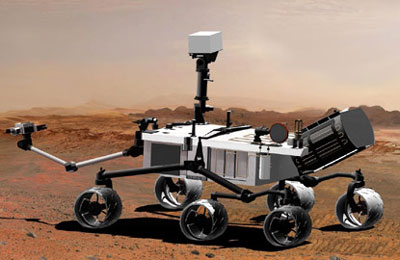
Mars rover finds traces of carbon
San Francisco , December 4, 2012
Nasa's Mars rover Curiosity, dispatched to look for the chemical ingredients and environments for microbial life, has found hints of carbon, though whether this building block for life on Earth has played a similar role on Mars is unknown, scientists said.
"Just finding carbon somewhere doesn't mean that it has anything to do with life, or the finding of a habitable environment," lead scientist John Grotzinger, with the California Institute of Technology, told reporters at the American Geophysical Union conference in San Francisco.
"If you have organic carbon and you don't have any water, you don't have a habitable environment," he said.
Even with carbon and water, life needs other chemicals, such as sulfur, oxygen, phosphorous and nitrogen, to form and evolve.
"It's not unexpected that this sand pile would not be rich in organics. It's been exposed to the harsh Martian environment," added planetary scientist Paul Mahaffy, with Nasa's Goddard Space Flight Center in Greenbelt, Maryland.
"It's really going to be an exciting hunt over the course of this mission to find early environments that might be protected from this surface Mars environment and see what we can add to the carbon story," Mahaffy said.
The rover, which in August touched down on the floor of a 93-mile wide (150-km) impact crater near the Martian equator, has already turned up evidence that its landing site was once covered in water.
Scientists do not know if the carbon compounds in the soil are contamination from Earth, arrived on the surface of Mars via comets or asteroids, or, if they are indigenous, whether they came from geological or biological activities on Mars.
"It tells us that we have a lead into a measurement of one of the important ingredients that adds to a habitable environment," Grotzinger said. "We still have a lot of work to do to qualify and characterize what it is."
The rover is expected to reach a richer slice of Martian history next year when it begins examining layers of sediment in a mountain rising from the floor of the crater.
"We're starting to find the spices that make a stew tasty. There are the basic ingredients that you expect to be there, but it's how you combine them and the minor ingredients that really turn out to be interesting," he said.
"What this mission is about is integrated science," Grotzinger added. "There is not going to be one single moment where we all stand up and on the basis of a single measurement have a hallelujah moment."
The rover also carries a radiation detector, intended to help Nasa figure out how much and what type of shielding would be needed for future planned human missions to Mars, a long-term goal of the US space program. - Reuters







